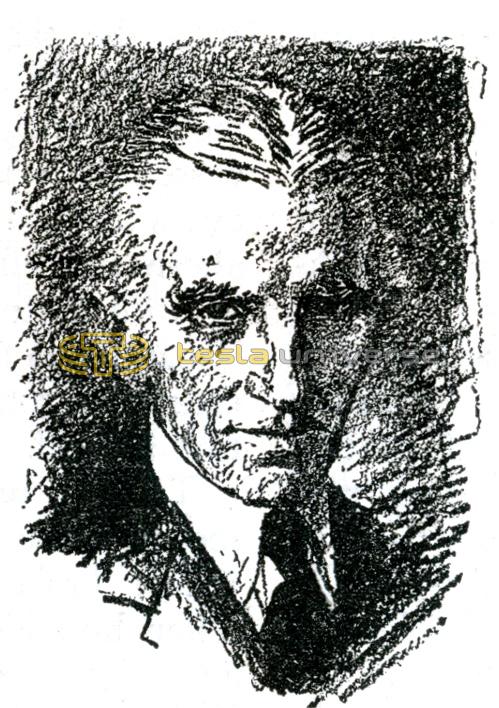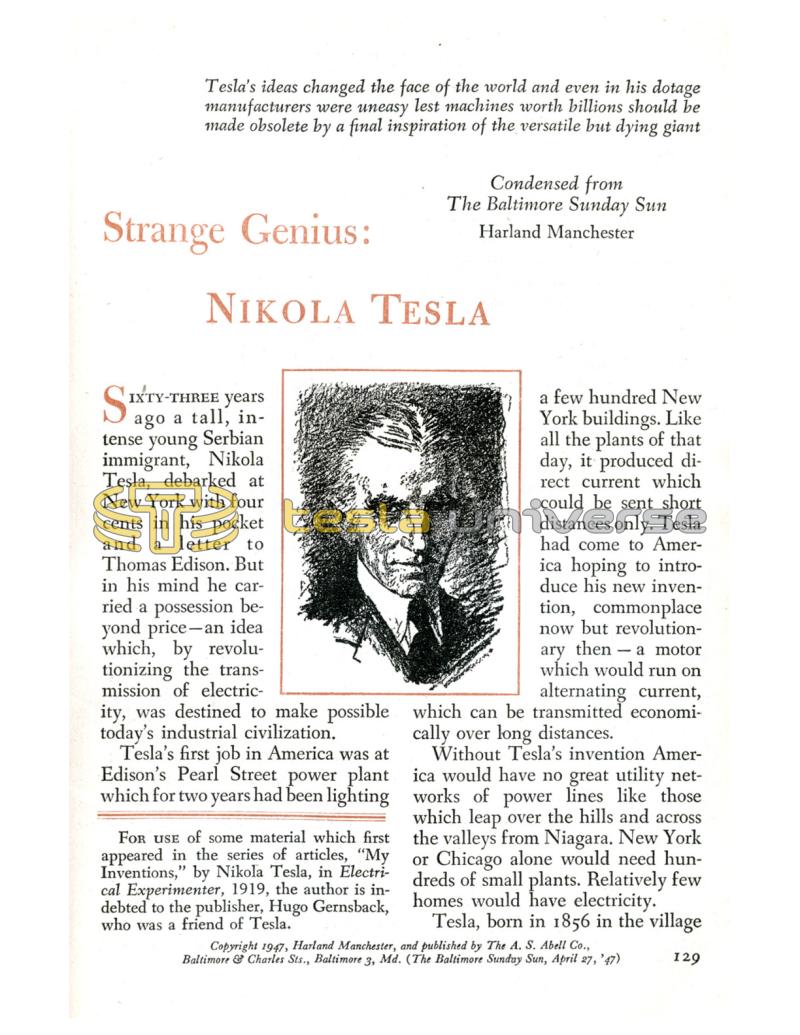
Nikola Tesla Articles
Strange Genius: Nikola Tesla
Tesla's ideas changed the face of the world and even in his dotage manufacturers were uneasy lest machines worth billions should be made obsolete by a final inspiration of the versatile but dying giant
Sixty-three years ago a tall, intense young Serbian immigrant, Nikola Tesla, debarked at New York with four cents in his pocket and a letter to Thomas Edison. But in his mind he carried a possession beyond price-an idea which, by revolutionizing the transmission of electricity, was destined to make possible today's industrial civilization.
Tesla's first job in America was at Edison's Pearl Street power plant which for two years had been lighting Condensed from The Baltimore Sunday Sun Harland Manchester a few hundred New York buildings. Like all the plants of that day, it produced direct current which could be sent short distances only. Tesla had come to America hoping to introduce his new invention, commonplace now but revolutionary then a motor which would run on alternating current, which can be transmitted economically over long distances.
For use of some material which first appeared in the series of articles, "My Inventions," by Nikola Tesla , in Electrical Experimenter, 1919, the author is indebted to the publisher, Hugo Gernsback, who was a friend of Tesla.
Copyright 1947, Harland Manchester, and published by The A. S. Abell Co., Baltimore Charles Sts., Baltimore 3, Md. (The Baltimore Sunday Sun, April 27, '47)
Without Tesla's invention America would have no great utility networks of power lines like those which leap over the hills and across the valleys from Niagara. New York or Chicago alone would need hundreds of small plants. Relatively few homes would have electricity.
Tesla, born in 1856 in the village of Smiljan, Yugoslavia, was a precocious child. When his father hid the candles to keep the boy from reading all night, he constructed a mold and made his own. He roamed the mountains dreaming up "inventions" such as a submarine tube to carry mail across the Atlantic.
Tesla had several physical crackups during adolescence. After one such illness, he persuaded his father, who wanted him to become a clergyman, that he might get well if he could go to engineering school. So Tesla, then 19, was sent to a technical school at Graz, Austria. There he was fascinated when one of his professors demonstrated a new direct current motor just received from Paris. But the brushes were sparking badly.
Tesla brashly suggested that a motor might be built without brushes, to avoid physical contact between the central rotating part and the outer fixed poles. Such a motor wouldn't spark and would be simpler to operate, he proclaimed excitedly; and it would work on "alternating" current.
"An impossible idea," the professor exclaimed, and all the textbooks supported him, but Tesla was confident and for six years filed away in his mind - he had a remarkable visual memory - all manner of data about the motor of his dreams.
Stopping his studies at the University of Prague after one year because he felt that his parents were making too great financial sacrifices, Tesla took a job with the Budapest July telephone company, but spent every minute of his spare time on his motor. Working around the clock brought a complete nervous breakdown. He even complained of hearing a dull thud as flies alighted on the table before him.
Fortunately, a friend took over, made him rest and exercise, and got him back in shape. One day they were walking in the park when Tesla suddenly shouted, "I've got it!" At last-in his mindhis motor stood complete and perfect. Picking up a stick, he sketched rapidly in the sand. For half an hour he "ran" the motor, starting and stopping it, while passers-by stared. He had worked out a method of sending a wave of alternating current through the coil of wire around the circular motor armature, so that the magnetic field constantly rotated, pulling the armature around.
To this revolution he added a second wave of alternating current which broke step with the first. Then he added a third. It was like adding more cylinders to an engine. This was the origin of "polyphase transmission," which plays an indispensable role in modern industry.
Tesla built his dream motor and was not at all surprised that it ran. Finding no backers in Europe, he set off for America, with a letter to Thomas Edison from an American engineer he had met. Racing for the boat train, he found his tickets and money had been stolen. Undeterred, he jumped on the train and talked his way across the Atlantic.
At first, Edison had reservations about this handsome, volatile European with his eloquent gestures and superior manner, and he gave him dirty, greasy jobs. But Tesla's brilliance and energy finally won a grudging admission that the foreigner was "a damn good man."
Tesla applied for, and got, a string patents and, after a year or so, set up his own laboratory to build his induction motors. In 1888 he read a paper before the American Institute of Electrical Engineers and started a mighty furor. Almost no one shared his conviction that alternating current was the key to electric-power development. George Westinghouse was a saving exception: he secured rights to the patents and hired Tesla to supervise the construction of the new motors and the new generators necessary for making the alternating current.
Alternating current was universally distrusted because of the high voltage generated. Edison, indeed, tried to secure legislation to outlaw it. Others pointed out that it was used in the new electric chair, and that it would be a public menace if sent over power lines. Tesla countered dramatically by submitti his body to 1,000,000 volts. Actually this had nothing to do with the case since he used extremely high frequencies which cause no pain, but it was a wonderful show.
Tesla's first great public triumph came in 1893, when 12 of his generators gorgeously illuminated 90,000 bulbs at the Chicago World's Fair. Three years later the foes of alternating current were silenced when the lights went on in Buffalo, 22 miles away from the giant new Tesla generators at Niagara Falls.
Tesla did not stay long with Westinghouse. Comparatively wealthy from the sale of his patents, he plunged into numerous projects in his New York laboratory. By rigorous exercise he had conquered his boyhood frailties, and now lived according to a rigid regime. He even believed that gum chewing damaged the system. He distrusted and avoided women, and foresaw a millennium of "desexualized workers" who would be sustained by love of work alone.
He had one elegant indulgence. Every night at eight he appeared in evening clothes at Delmonico's or the old Waldorf. Towering, impressive, aloof, he was conducted to his table where, beside his plate, was a stack of napkins. The headwaiter retained his composure while Tesla thoroughly wiped his dinner service, and, when he entertained, that of his guests. He ordered elaborate meals, cooked by his own recipes and accompanied by vintage wines. Then, rising from the table exactly at ten, he went to his laboratory to work the night through.
With the versatility of a da Vinci he pioneered in innumerable fields, dashing from one to another, too impatient to stick with one idea until its commercial possibilities were fully developed. He experimented with electrical illumination by means of gas-filled tubes - the precursors of neon and fluorescent lamps. He discovered the heating effect of short-wave currents on the human body, and suggested their use in treating disease.
In 1893 Tesla announced the principle of radio tuning and conducted successful tests in wireless transmission. He forecast a worldwide broadcasting system of news bulletins, music, stock prices and correct time, available to anyone by means of an inexpensive receiving set. He also predicted the broadcasting of photographs and drawings.
In 1898 a weird craft appeared in the sea off New York. Though no one was aboard, it dashed about in intricate patterns as though respond ing to human direction. This was Tesla's radio-controlled boat, ancestor of remotely controlled planes, craft and missiles. He proposed a radio-directed rocket similar to the German V-2, and predicted weapons of unlimited range against which no city could save itself; he warned that the release of the energy in the atom might bring disaster to mankind. One of his most spectacular inventions was the Tesla Coil. Every broadcasting antenna and every automobile ignition system in use today is an elaboration of it.
A great goal of Tesla's later life was the wireless transmission of electric power. Backed by John Jacob Astor, he built a mysterious laboratory in the Colorado mountains. No complete record of his experiments there exists, but it was reported that he succeeded in lighting lamps and running small motors more than 15 miles from the laboratory.
In his old age, Tesla became an eccentric recluse. He lived mainly on boiled milk and vegetables, in the hope of reaching 100. In the winter he seldom left his hotel room, which he kept at 90 degrees, with the doors and windows taped.
At the close of a stern life barren of love or affection, he was overcome by a curious devotion to pigeons. For years the gaunt, silent man in black with his bag of birdseed was a familiar sight in Bryant Park or on the steps of St. Patrick's Cathedral. When he could no longer go out, he had ailing pigeons brought to his room where he nursed them to health, stroking and admiring them for hours.
Every July 10 he gave a birthday party for newspapermen, and year by year his predictions became more lurid. He talked of harnessing "cosmic force," and of rays that would kill by the million and immobilize airplane engines hundreds of miles away. One reporter was heard to mutter, "If anyone but Tesla had said that, I'd say he was crazy.' Others were not so charitable.
He died on January 7, 1943, at 86, leaving among his papers a mass of conjectures and patents which have yet to be thoroughly sifted. It is possible that they may contain suggestions leading toward undreamed-of conquests in the field of science and that the last has not been heard of Nikola Tesla.

